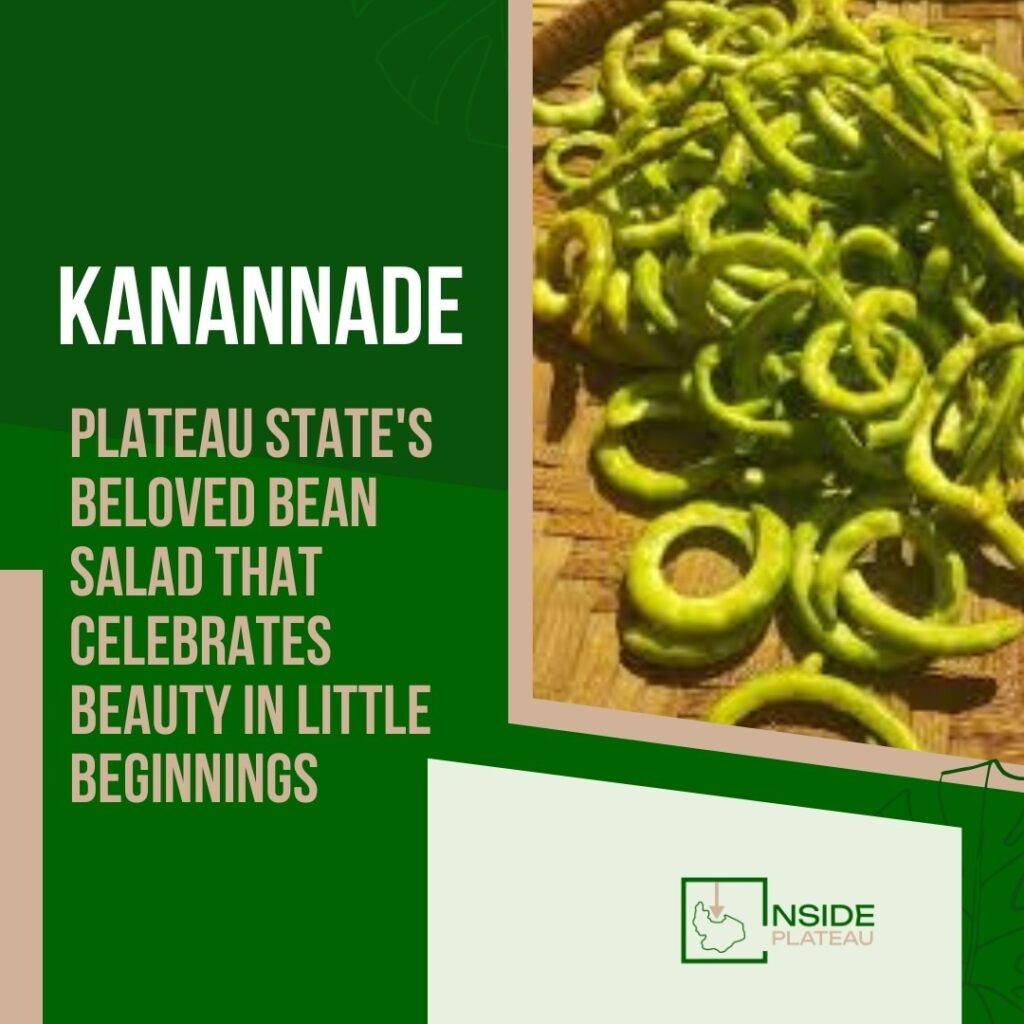If you’ve ever been to or lived in Plateau State and never tasted Kanannade, then perhaps you’ve only half-lived here. Ask anyone from Jos to Langtang, and they’ll tell you this is not just food, it’s memory, it’s identity, it’s Plateau on a plate. The dish has a way of sneaking into your story without you realizing it, becoming the taste you recall when you think of home, the flavor that makes Plateau unforgettable.
The Market Magic of Kanannade
Picture the bustle of Farin Gada market on a cool Jos morning. The air is thick with the aroma of spices, roasted corn, and fried akara. Women balance trays of fresh green pods on their heads, weaving gracefully through the crowd. Their calls rise and fall like music, rhythmic and familiar. And what are they selling? Kanannade—bright, tender pods of beans, not dried and shriveled as you might expect, but soft, green, and fresh from the farm.
It is in that state, before the beans inside have fully matured, that Kanannade is at its sweetest. Buy a handful, and you are not just purchasing food; you are carrying home a piece of Plateau’s soul. Each pod tells a story of patience, of beauty caught in its earliest stage, of nourishment that arrives before completion.
The Science Behind Kanannade
Now, here’s the part that startles most people: what Plateau calls Kanannade in Hausa is known to science as Vigna unguiculata—a species of cowpea, cousin to the more familiar black-eyed beans. Yet unlike the common cowpea, Kanannade is not left to dry or harden. It is plucked and eaten in its tender youth, when the pods are green and the beans inside have barely taken shape.
This is no accident of harvest. It is intentional, a philosophy in practice. Kanannade, like Plateau itself, does not wait for some distant “perfect” moment to be beautiful. It is proof that wonder can be found in little beginnings, that tenderness can hold its own kind of strength. Youthful, bright, and welcoming. Kanannade mirrors the people of the Plateau: hospitable, resilient, and full of promise. Even before the world fully recognizes their brilliance, they are already a delight to encounter.
A Tale of Two Bean Dishes
Beans in Plateau are more than sustenance; they are cultural artifacts, carriers of memory and tradition. Take Bubal, for example: the rich red kidney bean dish tied to festivals, weddings, and ceremonies. It is the kingly dish, the one that sits on tables draped with respect, always waiting for an occasion to justify its grandeur.
But Kanannade is different. It does not wait for celebration to announce its worth. It does not need ceremony to matter. Where Bíbal wears the robe of tradition, Kanannade walks barefoot through the markets, through the courtyards, through everyday life. It is the queen of simplicity, reigning in quiet beauty, reminding everyone that not all treasures need trumpets to be recognized.
Many Names, One Beloved Dish
This bean is not confined to one tongue or tribe. Across Plateau’s diverse ethnic tapestry, Kanannade wears many names, each spoken with love. The Berom call it Shamtuk. The Pyam call it Shanduk. Among the Pan, it is known as Chagaar. And in some communities, it is Isanduk. The names may differ, but the sentiment is the same: this is a dish deeply cherished, a staple woven into daily living.
Each name carries the weight of generations, of families who gathered around steaming bowls, of conversations carried late into the night. Kanannade has always been more than food. It is community, binding Plateau’s people with flavors as familiar as their mother tongues.
How to Cook Kanannade at Home
Kanannade is deceptively simple. Its magic lies in its freshness, in how little it demands and how much it gives. If you want to bring a taste of Plateau into your own kitchen, here’s how to do it:
Ingredients
● 4 cups of fresh Kanannade pods (harvested green and tender)
● 1 medium onion (chopped)
● 3 tablespoons palm oil (or vegetable oil)
● 2 fresh tomatoes (chopped)
● 2 scotch bonnet peppers (or to taste)
● 1 seasoning cube
● Salt to taste
● Water (just enough to cover the pods)
Instructions
1. Wash the pods thoroughly in clean water to remove dirt and grit. Trim off the edges like you would with green beans. The freshness of Kanannade is its gift treat it with care.
2. Boil the pods in a pot of water, just enough to cover them, for about 10–15 minutes until they soften and release their tender aroma.
3. Sieve away the excess water and set the pods aside once satisfied with the tenderness it has attained.
4. Prepare the sauce in a separate pan by heating palm oil. Add onions, tomatoes, and peppers. Fry gently until the mixture thickens, the colors deepen, and the oil begins to separate.
4. Season with salt and a seasoning cube, stirring until the flavors meld into a rich, fragrant base.
5. Combine the boiled pods with the sauce. Stir gently so that every bean pod is coated with flavor.
6. Simmer on low heat for five more minutes, letting everything come together in quiet harmony.
7. Serve hot with rice, or even alone as a meal in itself.
The beauty of Kanannade is that it never pretends to be more than it is, and yet it always tastes like more. Earthy but tender, simple yet unforgettable, it lingers long after the last spoonful. To taste Kanannade is to taste Plateau itself; the proof that beginnings can be beautiful, that tenderness has its own strength, and that wonder is often found in the simplest places.

